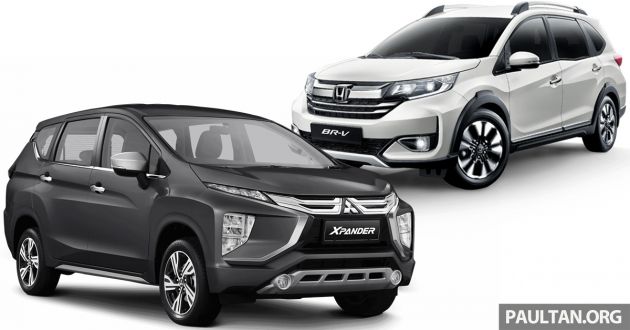Mitsubishi Xpander vs Honda BR-V – spec-by-spec comparison of 7-seat MPVs ahead of Xpander launch
At long last, Mitsubishi Motors Malaysia (MMM) has confirmed that the Xpander is finally, finally coming to Malaysia. The seven-seat MPV-cum-SUV will be launched later this year with its eyes firmly set on taking on its biggest rival, the Honda BR-V – so we thought it would be a good idea to compare the specifications of the two cars.
Let’s get some housekeeping out of the way first. We don’t have any details of the local Xpander as yet, so the figures you see here are based on the Indonesian model. Pricing is still an unknown quantity for the Mitsubishi, but we expect it to be in a similar ballpark to the Honda, which retails at RM86,726 for the 1.5 E and RM93,420 for the 1.5 V.
If you’re looking for the bigger car, then Mitsubishi scores first blood. The Xpander is slightly larger than the BR-V in every dimension – 18 mm longer (4,475 mm), 15 mm wider (1,750 mm) and 23 mm taller (1,700 mm), with a 113 mm longer wheelbase (2,775 mm). This should translate into a roomier interior, and the Xpander also boasts a much larger boot with the third row folded, at 781 litres versus 539.
Speaking of folding the seats, Mitsubishi claims that the Xpander is the only car in its class with fold-flat second and third rows, whereas the BR-V’s seats are positioned above the floor and need to be tumbled out of the way to get full luggage space. This gives the Xpander a more car-like boot that makes it easier to load larger or longer items.
However, the Xpander has a less powerful engine to lug the larger body. Despite the 1.5 litre MIVEC four-cylinder having double overhead cams versus the Honda’s single-cam i-VTEC mill, it produces less power and torque at 105 PS and 141 Nm, against the BR-V’s 120 PS and 145 Nm. However, peak power and torque are produced lower in the rev range in the Mitsubishi, at 6,000 and 4,000 respectively, which should make for a less stressed engine.
Elsewhere, the Xpander has a minimally taller ground clearance at 205 mm, as well as a slightly tighter turning circle at 5.2 metres, versus 5.6 metres for the BR-V. On to the specs, and the Xpander again edges ahead with LED headlights introduced on the facelift, compared to projector halogens on the BR-V. It also gets telescopic adjustment for the steering wheel, rather than only tilt adjustment for the Honda.
Both the Xpander and BR-V are available with seven-inch infotainment touchscreens, although MMM may add its own aftermarket system that could redress the balance – an Apple CarPlay/Android Auto-compatible system, as seen in the Outlander and Triton, would hand the Xpander a huge advantage. It’s also level pegging in the safety department, with both cars being offered with dual airbags, ABS with EBD and brake assist, stability control, hill start assist and ISOFIX child seat anchors on the second row.
Given our conservative market, the Xpander will likely be offered with a black interior, whereas Indonesian models are also available with a beige colour scheme.
GALLERY: Mitsubishi Xpander facelift in Indonesia 













GALLERY: Honda BR-V facelift in Malaysia 

































The post Mitsubishi Xpander vs Honda BR-V – spec-by-spec comparison of 7-seat MPVs ahead of Xpander launch appeared first on Paul Tan's Automotive News.
from Paul Tan's Automotive News
Read The Rest:paultan...







Post a Comment